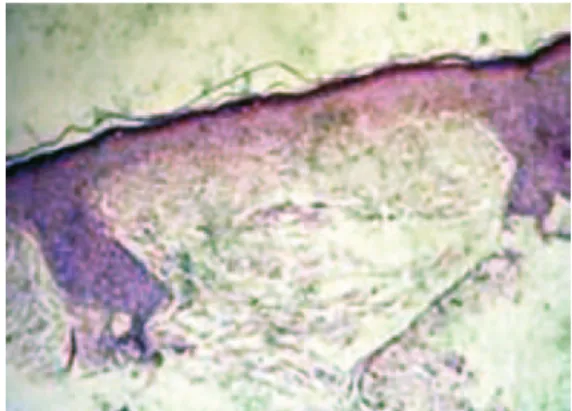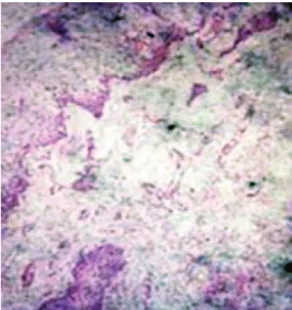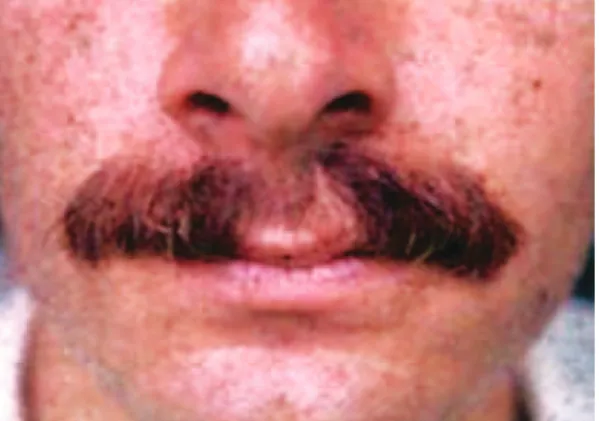Rev Bras Cir Plást. 2013;28(2):310-3 310
Gonella HA & Campos DLP
Histopathology of Keith’s lip scar
Histopatologia da forma labial cicatricial de Keith
This study was performed at the Faculty of Medical and Health Sciences of Sorocaba,
Pontiical Catholic University of São Paulo (PUC-SP),
Sorocaba, São Paulo, Brazil.
Submitted to SGP (Sistema de Gestão de Publicações/Manager
Publications System) of RBCP (Revista Brasileira de Cirurgia
Plástica/Brazilian Journal of
Plastic Surgery). Article received: September 16, 2010 Article accepted: November 5, 2010 Hamilton aleardo
Gonella1 décio luís Portella de camPos2
Franco T et al. Vendramin FS et al.
CASE REPORT
ABSTRACT
Examinations of the etiology of congenital cicatricial presentations, which include congeni
-tal constriction bands and cicatricial presentations of cleft lip, have provided several theories that explain their development; however, they do not explain all the aspects involved in
these malformations. In the present article, we present the cases of 4 patients with Keith’s lip scar who underwent cheiloplasty using the spina technique. These cases were compared
with 1 case of a patient with a traumatic scar. Tissue samples were obtained from all the patients for histopathological examination using hematoxylin-eosin staining. The cases
under study exhibited similarities in embryonic skin and common scar tissue.
Keywords: Cleft lip. Lip diseases. Mouth abnormalities. Amniotic band syndrome.
RESUMO
O estudo da etiologia das formas congênitas ditas cicatriciais, que incluem bandas cicatri
-ciais congênitas e formas cicatri-ciais das issuras labiais, apresenta diversas teorias, que fundamentam seu aparecimento, porém não justiicam todos os aspectos envolvidos nessas malformações. Neste artigo são apresentados 4 casos de pacientes portadores da forma
cica-tricial de Keith, submetidos à realização de queiloplastia pela técnica de Spina, comparados
a 1 caso de paciente portador de cicatriz traumática. Todos os pacientes tiveram amostra de tecido enviada para estudo histopatológico, com coloração com hematoxilina-eosina. Os
casos estudados apresentaram semelhanças entre a pele embrionária e a cicatriz comum.
Descritores: Fenda labial. Doenças labiais. Anormalidades da boca. Síndrome de bandas
amnióticas.
1. Plastic surgeon, full member of the Sociedade Brasileira de Cirurgia Plástica (Brazilian Society of Plastic Surgery - SBCP), full professor at the Depart-ment of Surgery of the Faculdade de Ciências Médicas e da Saúde de Sorocaba da Pontifícia Universidade Católica de São Paulo (Faculty of Medical and Health Sciences of Sorocaba, Pontiical Catholic University of São Paulo - PUC-SP), Sorocaba, SP, Brazil.
2. Plastic surgeon, associate member of the SBCP, former resident at the Department of Surgery of the Faculdade de Ciências Médicas e da Saúde de
Sorocaba da Pontifícia Universidade Católica de São Paulo (Faculty of Medical and Health Sciences of Sorocaba, Pontiical Catholic University of São Paulo - PUC-SP), Sorocaba, SP, Brazil.
INTRODUCTION
Despite the fast pace of the research in this ield, the
knowledge on the pathogenicity of congenital malforma tions has not increased by a great extent.
In 1976, we assessed congenital malformations known
as cicatricial malformations1 in the cleft lip and palate, which include congenital constriction bands of the limbs and Keith’s lip scars2. Since then, no signiicant scientiic
advances in this ield have been made. Several theories ad -dress distinct aspects of the malformations; however, they do not offer a comprehensive explanation that could provide a
solution to the problem.
Some authors such as Brindeau et al.3 argue that
conge-ni tal constriction bands of the limbs are caused by amconge-niotic
ano malies. However, other researchers state that the amnio tic anomalies are a result and not the cause of congenital cons
-triction bands of the limbs. Streeter4 postulated that fo cal
dei-ciency develops in fetal tissues as a result of fai lu re of these structures, which prevents their full development. According
to Inglis5, focal deiciency of fetal tissues is caused by intrinsic
and extrinsic factors during an early stage of development.
Patterson6 claimed that the congenital constriction bands
of the limbs are mainly the result of errors in the
Rev Bras Cir Plást. 2013;28(2):310-3 311
Histopathology of Keith’s lip scar
Although many theories have been put forward regar
-ding the etiology of these “cicatricial” presentations, and some authors such as Swanson et al.7 have compared them to a
bridge-shaped scar of a third-degree burn, other researchers
are more cautious and state that these congenital malforma -tions only resemble a scar4.
Given the contradictory opinions found in the literature, the aim of the present work was to conduct a histopathologi
cal study of cicatricial lip presentations.
CASE REPORTS
This article presents the cases of 4 patients with Keith’s lip scar who underwent cheiloplasty using the spina tech
-nique. These cases were compared to 1 case of a patient with
a trau matic scar.
Tissue samples were obtained from all the patients for
histopathological examination using hematoxylin-eosin
staining.
Case 1
A 17-year-old female patient presented with Keith’s lip
scar, cleft nose, and congenital fistulas of the lower lip
(Figure 1). The result of the histological examination of the
tissue sample obtained during cheiloplasty showed a thin epidermis with melanin pigment in the basal layer and few
dermal papillae (Figure 2). The dermis exhibited dense con -nective tissue. Skin adnexa, normal blood vessels, and nerve fascicles were present, in addition to a mildly basophilic amor
-phous substance.
Case 2
A 46-year-old male patient presented with Keith’s lip scar and cleft nose (Figure 3). The result of the histological
Figure 1 – Case 1. Patient with Keith’s lip scar, cleft nose, and congenital istulas of the lower lip.
Figure 3 – Case 2. Patient with Keith’s lip scar and cleft nose.
Figure 4 – Case 2. Result of the histological examination of a
sample obtained during cheiloplasty, showing a thin epidermis with the presence of melanin pigment in the basal layer and absence of
dermal papillae and dense connective tissue in the dermis.
Figure 2 – Case 1. Result of the histological examination
of a sample obtained during cheiloplasty, showing a thin epidermis with the presence of melanin pigment in the basal layer
and few dermal papillae.
Rev Bras Cir Plást. 2013;28(2):310-3 312
Gonella HA & Campos DLP
layer and the absence of dermal papillae and dense connec
-tive tissue in the dermis (Figure 4). In addition, skin adnexa, normal blood vessels, and nerve fascicles were present.
Case 3
A 12-year-old male patient presented with Keith’s lip scar and cleft nose (Figure 5). The result of the histological
examination of the sample obtained during cheiloplasty showed a thin epidermis with melanin pigment in the basal
layer and dermal papillae (Figure 6). The dermis exhibited dense connective tissue. Skin adnexa were present in large quantities; moreover, only few blood vessels were present, and nerve fascicles were absent.
Figure 5 – Case 3. Patient with Keith’s lip scar and cleft nose.
Figure 6 – Case 3. Result of the histological examination
of a sample obtained during cheiloplasty, showing a thin epidermis with the presence of melanin pigment in the basal layer
and dermal papillae.
Figure 7 – Case 4. Patient with Keith’s lip scar and cleft nose.
Figure 8 – Case 4. Result of the histological examination of a
sample obtained during cheiloplasty, showing a thick epidermis and fewer but differentiated dermal papillae.
Case 4
A 43-year-old male patient presented with Keith’s lip scar and cleft nose (Figure 7). The result of the histologi cal exa
-mination of the sample obtained during cheiloplas ty sho wed
thick epidermis and few, though differentia ted, dermal pa -pillae (Figure 8). The dermis exhibited dense connective tissue. Skin adnexa and few blood vessels were absent.
Case 5
Rev Bras Cir Plást. 2013;28(2):310-3 313
Histopathology of Keith’s lip scar
DISCUSSION
Structural and/or metabolic congenital anomalies occur
in 3–4% of the population aged <1 year. Thus, growth and fusion of embryonic buds (when referring solely to the face) occur in an environment favorable to small structural “errors”
and, as Keith2 clariied, this is an “in utero” scarring that does
not leave marks or sequelae.
In the present study, we observed that the congenital scar
exhibits histological features similar to those of a common scar, which is formed “extra utero,” and other features similar to those of embryonic skin. In addition, the presence of the
melanin pigment and the absence or scarcity of dermal pa
-pillae were noted. The dermis was either normal or exhibited
an amorphous substance similar to that observed during
hyalinization, which resembles scarring. In some aspects,
such as in case 2, it is very similar to an embryonic stage of skin development.
Therefore, the congenital scar is a mosaic that reveals a natural error, which many researchers have tried to explain through a variety of theories that may explain some but not
all cases. We agree with Keith2 when he referred to an “in
utero”scar; in fact,if we were able tounderstand and study in greater detail all the phenomena regarding the fusion of embryonic buds, and if we could simulate the same parame -ters and intrauterine conditions when performing surgery, we
would be able to operate without leaving noticeable scars in
most cases.
REFERENCES
1. Gonella HA. Histopatologia das formas congênitas ditas cicatriciais. In:
XIII Congresso Brasileiro de Cirurgia Plástica, I Congresso Brasileiro
de Cirurgia Estética; 1976; Porto Alegre. p. 303-4. 2. Keith A. Evolutionary wounds. Br Med J. 1921;2:137-9.
3. Brindeau A, Latuejoul P, Chappaz G. Des malformations d’origine amniotique arrest de developpement ou maladies de la membrane amnio tique. Sem Hop Paris. 1952;71:2269.
4. Streeter GL. Focal deiciencies in fetal tissues and their relation to intrauterine amputations. Cont Embryol. 1930;22:1.
5. Inglis K. The nature of agenesis and deiciency of parts: the inluence of intrinsic factors in disease when development of the body is abnormal,
as illustrated by agenesis of the digits, facial hemiatrophy, and cerebral
agyria and microgyria. Am J Pathol. 1952;28(3):449-75.
6. Patterson TJ. Congenital ring-constrictions. Br J Plast Surg. 1961;14:1-31. 7. Swanson AB, Barsky AJ, Entin MA. Classiication of limb malforma-tions of the basis of embryological failures. Surg Clin North Am. 1968; 48(5):1169-79.
Figure 10 – Case 5. Result of the histological examination result showing a thin epidermis and the absence of dermal papillae.
Figure 9 – Case 5. Patient with a traumatic scar.
Correspondence to: Hamilton Aleardo Gonella


